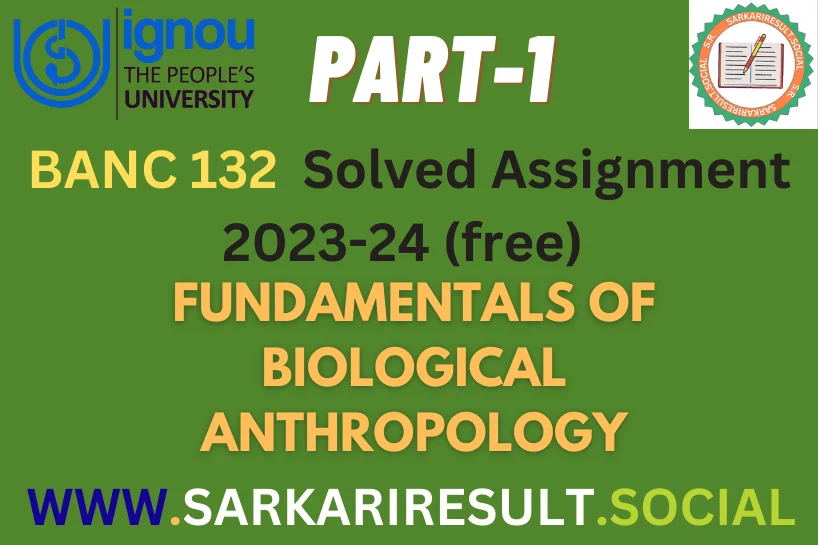BANC 132 IGNOU Solved Assignment 2023-24 (free) Part-1

BANC 132 IGNOU Solved Assignment 2023-24
“Embark on a fascinating journey into the world of BANC 132 IGNOU Solved Assignment 2023-24 (free) Part-1 with this Tutor Marked Assignment (TMA) for BANC-132. In Assignment – I, explore the essence of biological anthropology and its wide-ranging aims and scope, along with a deep dive into anthropological epidemiology. These two questions, answered in about 500 words each, provide a solid foundation for your understanding of this field. Score high marks by our solved IGNOU assignments 2023-24 and excel in your studies.”

Q.1 Define biological anthropology and discuss its aims and scope.
Ans. Biological anthropology is a subfield of anthropology that focuses on the study of human biology and evolution. It seeks to understand the biological aspects of humanity, including our evolutionary history, physical variations, and interactions with the environment. This discipline is often referred to as physical anthropology and plays a crucial role in unraveling the complex story of human origins and development.
Check BGDG 172 IGNOU solved assignment 2023-24 (Free)
Aims of Biological Anthropology:
1. Understanding Human Evolution: One of the primary aims of biological anthropology is to investigate the evolutionary history of humans and our closest relatives. Researchers in this field study fossil evidence, genetic data, and comparative anatomy to trace the lineage of hominins (human ancestors) and explore the factors that led to the emergence of modern Homo sapiens.
2. Exploring Human Variation: Biological anthropologists investigate the physical variations among human populations. This includes the study of genetic diversity, racial and ethnic differences, and adaptations to different environments. Understanding these variations helps us appreciate the complexity of human biology.
3. Primatology: Many biological anthropologists also study non-human primates, our closest relatives in the animal kingdom. This research sheds light on our own evolution, behavior, and cognitive abilities. Observations of primates in the wild and in captivity provide valuable insights into social structures, communication, and tool use.
4. Human Adaptation and Biocultural Interaction: This field explores how humans have adapted to various environments and how culture interacts with biology. Researchers investigate how diet, disease, and lifestyle impact human biology and health. This knowledge can inform public health and policy decisions.
Discover BPAG 174 ignou solved Assignment (Free) 2023-24
5. Forensic Anthropology: Biological anthropologists play a crucial role in forensic science, helping to identify human remains and determine causes of death in criminal investigations and mass disasters. They use their expertise in skeletal biology to provide vital information to law enforcement and legal authorities.
6. Bioarchaeology: Bioarchaeologists examine ancient human remains to understand past populations, their health, and their lifestyles. By analyzing skeletal remains and artifacts, they reconstruct aspects of ancient societies, shedding light on the lives of our ancestors.
Scope of Biological Anthropology:
1. Paleoanthropology: This branch focuses on the study of fossilized remains of early hominins and other primates to reconstruct the evolutionary history of humans. Researchers in this field aim to answer questions about the origins of bipedalism, brain expansion, and the emergence of symbolic thought.
2. Human Genetics: Genetic studies within biological anthropology delve into the diversity of human populations, tracing migration patterns, and exploring the genetic basis of disease susceptibility and adaptation to different environments.
3. Human Growth and Development: Understanding the growth and development of humans from infancy to adulthood is a key aspect of biological anthropology. This research provides insights into the effects of nutrition, disease, and environmental factors on human biology.
4. Primate Behavior and Ecology: Biological anthropologists who specialize in primatology observe and analyze the behavior and ecological interactions of non-human primates. This research helps us better understand the social structures, communication, and cognitive abilities of primates.
5. Human Osteology and Forensics: Experts in this field identify human remains and provide information about an individual’s age, sex, ancestry, and cause of death. They contribute significantly to criminal investigations, disaster recovery efforts, and archaeological excavations.
In conclusion, biological anthropology is a multidisciplinary field that seeks to uncover the biological foundations of humanity. It combines genetics, paleontology, anatomy, and ecology to address fundamental questions about human evolution, diversity, and adaptation. Its scope encompasses a wide range of topics, from ancient hominin fossils to the genetics of contemporary populations, making it a crucial discipline for understanding the complex tapestry of human existence.
Check BSOG 176 IGNOU solved assignment 2023-24 (Free)
Q.2 Discuss anthropological epidemiology.
Ans. Anthropological epidemiology is an interdisciplinary approach that combines the methods and theories of anthropology with epidemiology to better understand the complex relationships between human health and culture. This field recognizes that health is not solely determined by biological factors but is deeply influenced by social, cultural, and environmental contexts. In this discussion, we’ll delve into anthropological epidemiology, its key concepts, methods, and its significance.
Key Concepts in Anthropological Epidemiology:
1. Culture and Health: Anthropological epidemiology acknowledges that cultural beliefs, practices, and social norms have a profound impact on health outcomes. Cultural factors can influence everything from dietary choices and healthcare-seeking behaviors to the perception of illness and healing practices.
2. Local Knowledge and Beliefs: Anthropological epidemiologists pay close attention to the local knowledge and beliefs within a community. Understanding how people perceive health, illness, and the causes of disease is essential for effective public health interventions.
3. Social Determinants of Health: This field emphasizes the role of social determinants of health, such as income, education, access to healthcare, and living conditions. These factors can significantly impact the distribution of diseases within populations.
4. Health Disparities: Anthropological epidemiologists examine health disparities within and between populations. They investigate why certain groups are more vulnerable to specific diseases and how social, economic, and cultural factors contribute to these disparities.
Check “latest” BPCG 175 Ignou Solved Assignment (Free) in 2023-24
Methods in Anthropological Epidemiology:
1. Participant Observation: Anthropological epidemiologists often engage in participant observation, living within communities and observing their daily lives. This immersive approach helps researchers gain insight into local customs, healthcare practices, and perceptions of health and illness.
2. In-Depth Interviews: Conducting in-depth interviews allows researchers to collect detailed information about individuals’ health experiences, beliefs, and behaviors. These interviews help uncover culturally specific factors that influence health.
3. Surveys and Questionnaires: Quantitative data collection methods are also used to gather information about health behaviors and practices within a community. Surveys and questionnaires help researchers identify patterns and trends in health-related behaviors.
4. Ethnographic Research: Ethnographic research involves long-term immersion in a community, often spanning months or years. Researchers develop a deep understanding of the community’s culture, health practices, and social dynamics.
Significance of Anthropological Epidemiology:
1. Improved Healthcare Interventions: Anthropological epidemiology provides valuable insights into the cultural and social factors that influence health. This knowledge helps public health practitioners develop more culturally sensitive and effective interventions.
2. Health Equity: By examining the social determinants of health and health disparities, anthropological epidemiology contributes to efforts to reduce health inequalities. It highlights the need for policies and programs that address root causes of disparities.
3. Crisis Response: In times of public health crises, such as disease outbreaks or natural disasters, anthropological epidemiology can play a critical role in understanding community responses and tailoring interventions to the specific needs of affected populations.
4. Global Health: As the world becomes more interconnected, understanding the cultural context of health is crucial for global health initiatives. Anthropological epidemiologists contribute to the development of culturally appropriate strategies for addressing health challenges worldwide.
Check top Begae 182 IGNOU solved assignment 2023-24 (Free)
In conclusion, anthropological epidemiology is a vital subfield that recognizes the intricate interplay between culture, society, and health. It provides a holistic approach to understanding and addressing health issues by considering the social and cultural context in which they occur. This interdisciplinary approach is essential for creating more effective public health interventions, reducing health disparities, and improving the overall well-being of communities around the world.







